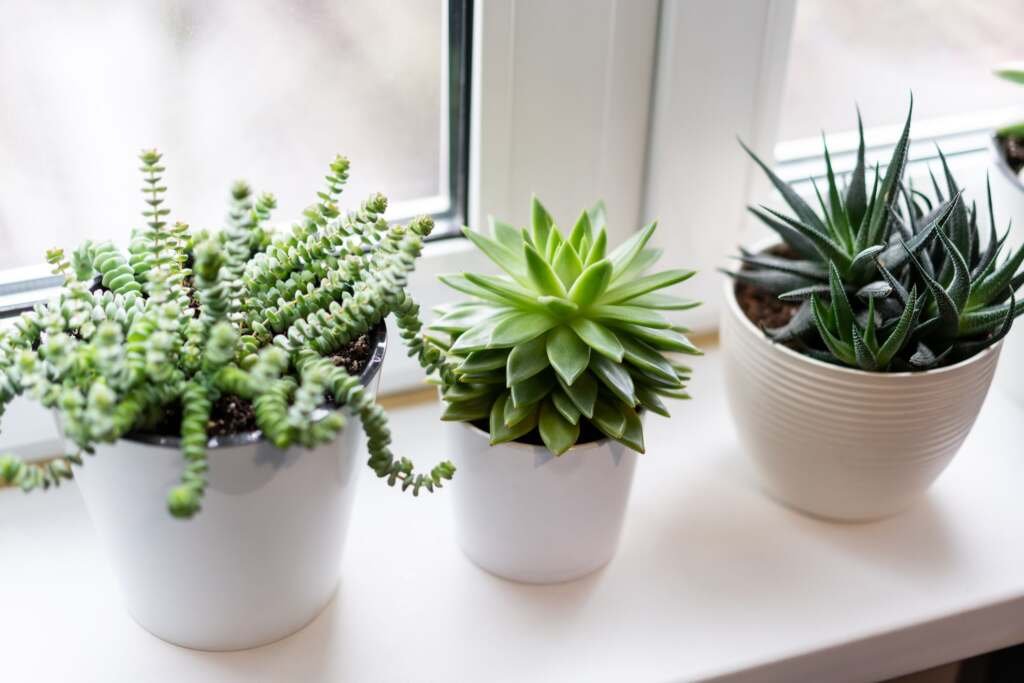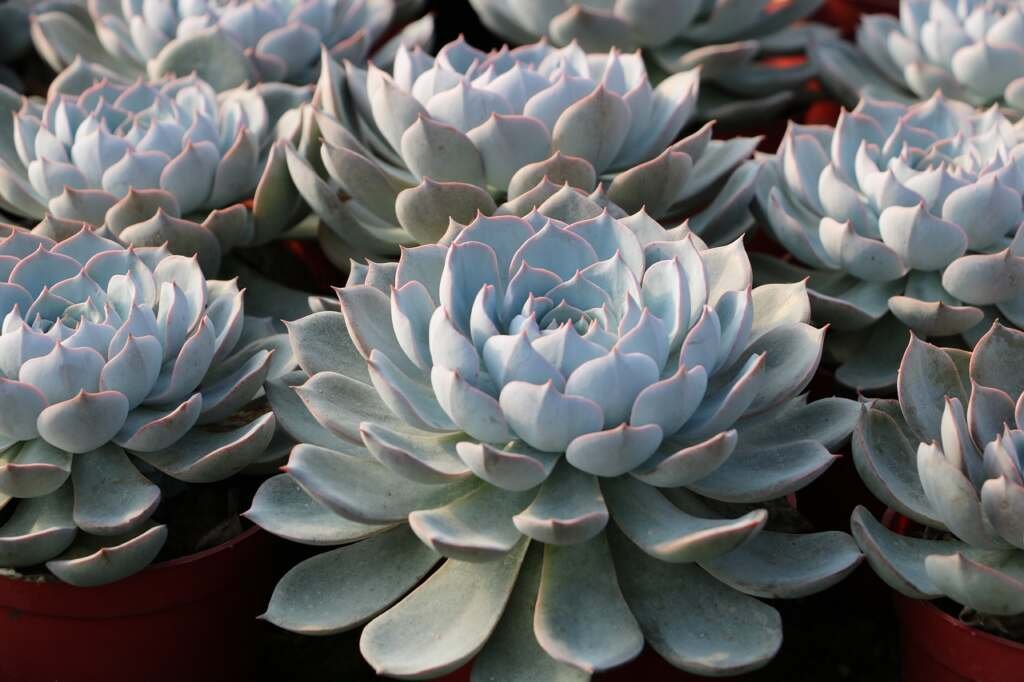HOW TO PROTECT SUCCULENTS IN RAINY SEASON

Although cacti and succulents are known to be drought-resistant plants due to their ability to store water in their stems and leaves, they love getting a good soak of water to keep them alive and grow healthy. Just not too much, as allowing them to stay in excess moisture conditions or leaving the soil wet for too long or may invite issues like pests or fungi infestation, and root rot.
So if you are growing succulents outdoors, the rainy season is indeed something to be concerned about, especially for tender succulents like Echeveria, Crassula, or Kalanchoe, which are more sensitive to moisture compared to other succulent varieties.
However, there are a few ways you can try to help you protect your succulents from rain. Read on to learn more!
CAN RAIN KILL SUCCULENTS?
A little rain won’t actually harm your succulents. In fact, it will help wash away all the dirt and chemicals from the plant’s soil, and at the same time, give the required nitrogen to the succulents. Rains that are too frequent and heavy, on the other hand, are something that you should be alarmed about. So if you live in an area where it tends to rain heavily and too frequently, remember to give your succulents outdoors some protection, or better yet, bring them indoors for safety, especially if;
- Your pots don’t have drainage holes. You can drill one yourself if need to.
- Your succulents are planted in a container or pot made of metal or wood. Keep in mind that metal may rust when wet and dry, and if this rust gets into the soil of your succulents, it may harm their roots. Wood containers, on the other hand, can deteriorate, which will result in fungus and bacterial growth.
- The succulents are planted in a pot with poor or unsuitable soil mix. Unlike in-ground succulents, potted ones don’t have unlimited space for their roots to grow and find the nutrients they need during the rainy season, and therefore, moving them indoors would be the best decision.
- You live in an area where you get over 25 to 30-inches of annual rainfall unless you have designed your outdoor garden with a nice slope of well-draining soil.

The rain helps wash away all the dirt and chemicals from the plant’s soil, and at the same time, give the required nitrogen to the succulents.
HOW TO PROTECT SUCCULENTS FROM TOO MUCH RAIN?
In the event that you choose to leave your succulents outdoors during the rainy season or just couldn’t bring them indoors as they are planted in the ground, then here are some ways you can try to help protect your succulents.
1. Cover up your outdoor succulents(either planted in the ground or potted ones) using either an umbrella (one with strong bases), a tent or shelter, a tarp, or a UV plastic sheet, or a polycarbonate sheet. Using one of these should be enough to help lessen the risk of root rot, as it will shield the plants from a lot of water or moisture getting in contact with them.

2. Improve Airflow. One reason why rain becomes a concern to succulents is fungal infections due to moist conditions. And by improving the airflow, the risk of your succulents getting fungi disease will be lessened, making your succulents have a higher chance of surviving the rain.
You can do this by elevating your in-ground succulents above the ground (about 5 to 6-inches high), by creating a small trench in front of them, allowing the wind to move up the mounds of soil and through the succulents (helping the soil to dry out), and at the same time, let the water run down the slope rather than being collected below them. For potted succulents outdoors, you just have to make sure that your soil has a layer of gravel or stones to the base of the container, as this will promote better drainage and airflow.
3. Prune Succulents. How does pruning help? Dead leaves or stems under or around your plant’s stem may encourage rot after rainfall, as it can trap water beneath or around the succulent, leading the soil to be moist, which is a favorable environment for bacteria, and by checking your succulents now and then, and pruning or removing the infected parts early helps prevent all this to happen. Just make sure to use a pair of gardening gloves when handling and garden tweezers when pruning cactus with spines. Read here to learn more about pruning succulents.

Dead leaves or stems under or around your plant’s stem may encourage rot after rainfall.
For succulents grown in containers, you need to make sure that you use porous pots. Keep in mind that using a pot that’s made out of the wrong materials will result in bigger problems for your succulents outdoors during the rainy season. For example, plastic pots retain moisture and humidity, which will increase the risk of issues of rot and pest infestations. Terracotta pots and other clay-based pots, on the other hand, are made of breathable materials, and at the same time, allow water to evaporate quickly, reducing the risk of your succulents getting root or leaf rot. If you want to know what other choices of pots you can use, check out our CHOOSE THE RIGHT POT MATERIAL FOR SUCCULENTS blog.
4. Pay attention to the Weather forecast. This will help you be aware and make proper arrangements for your succulents in advance, allowing you to be well prepared to face future weather conditions.

Weather forecast can help you be aware and make proper arrangements for your succulents in rainy season.
5. Avoid touching the Farina. Succulents like Echeveria, Kalanchoe, and Graptoveria, have a white or bluish silver coating on the leaves or stems called epicuticular wax, or also known as farina. This helps the plant repel water during the rainy season and protects it from the scorching sun. And since they can easily get brushed away, touching might accidentally remove this layer from the plant, risking them from getting sunburned or even root rot during the rainy season.

Touching the farina might accidentally remove this layer from the plant, risking them from getting sunburned or even root rot during the rainy season.
Photo credit: ssucsforyou.com
WHAT TO DO AFTER THE RAIN?
1. Pour out excess water from succulents planted in pots without drainage holes by simply tipping the pot. This will not only pour out the excess water from the pot but also helps the soil to dry out quicker.
2. Remember to throw away any collected water on the pot’s saucer after heavy rain. And make sure to give the pot a chance to dry out by setting the saucer aside for a few days first before putting it back in place. Doing this will prevent your succulents from sitting in wet for too long, hence, reducing the risk of root rot.
3. Since succulents tend to easily rot if stayed wet for too long, quickly wipe or remove any water that pools on their leaves after a heavy rain. Do this for your succulents grown on both as a container plant or the ones planted in the ground.
4. Move your potted succulents to a sunny spot in your outdoor garden, and remove the cover you used to protect your succulents planted in the ground to allow them to dry out quickly as the sun will help evaporate the water faster.


